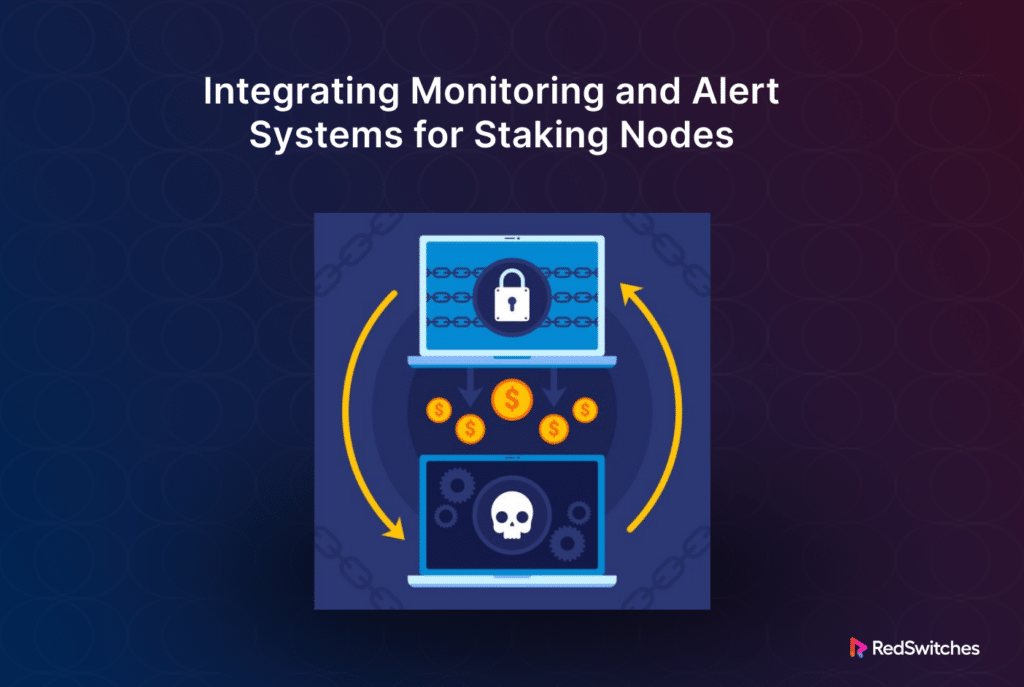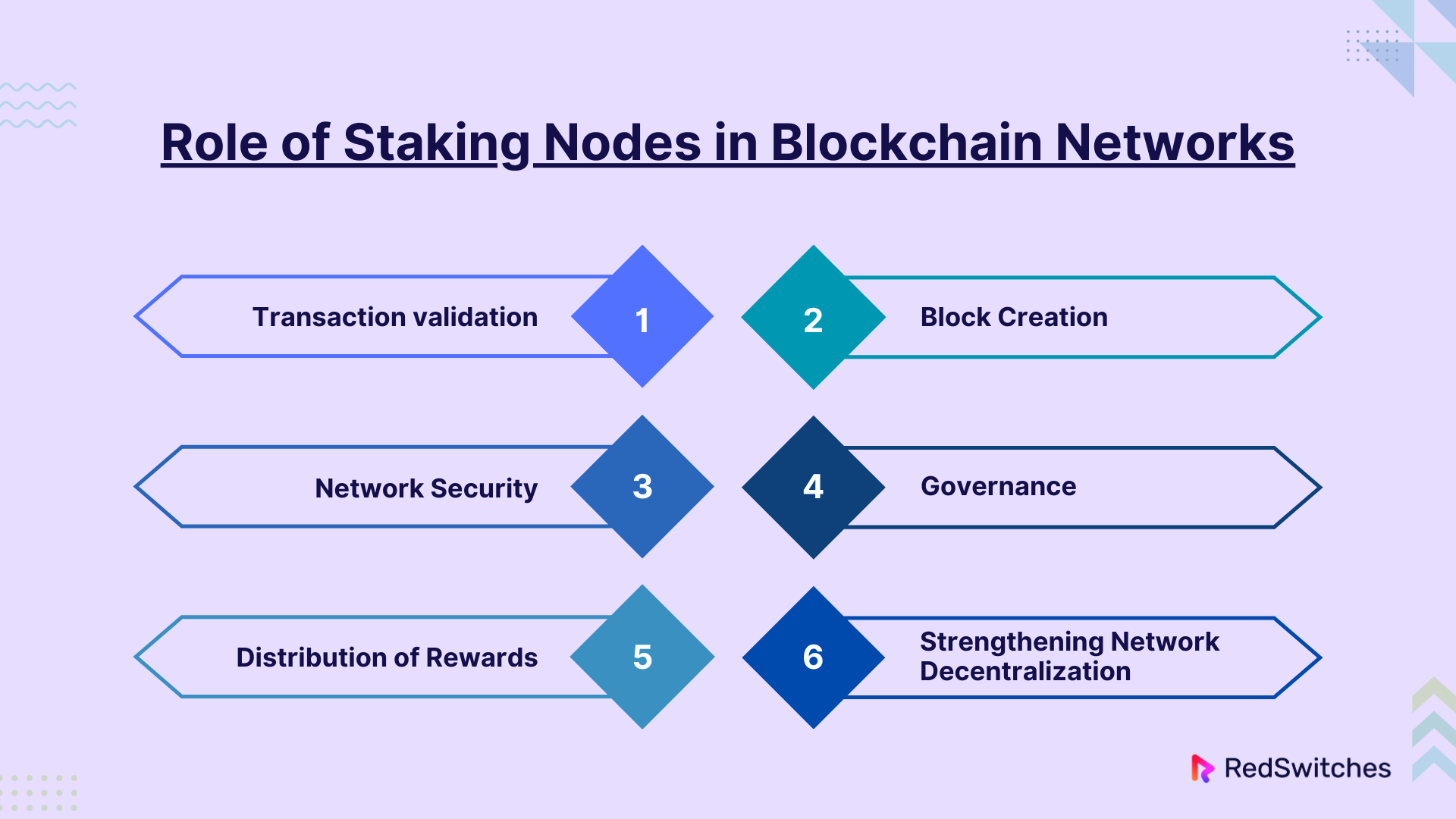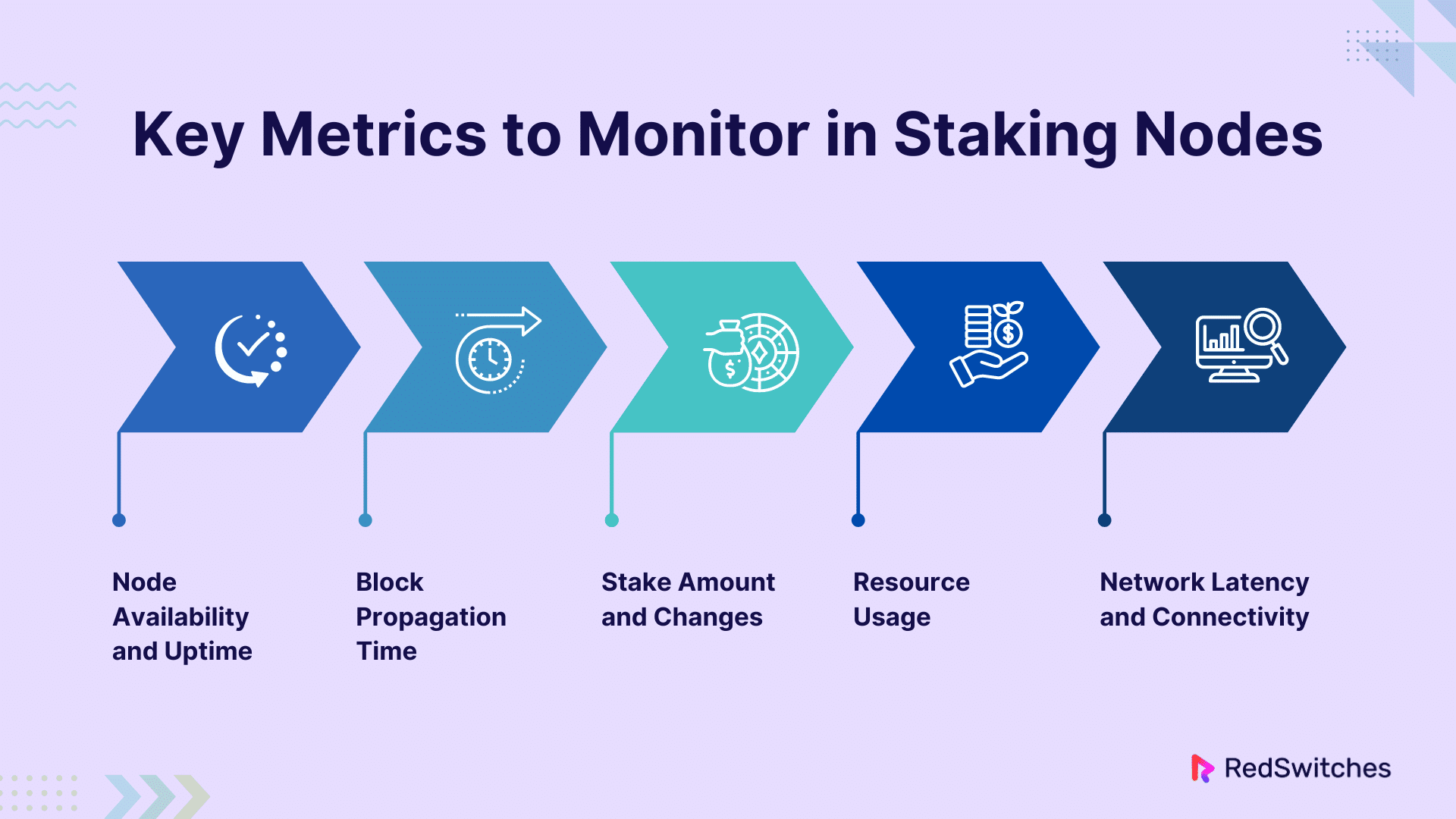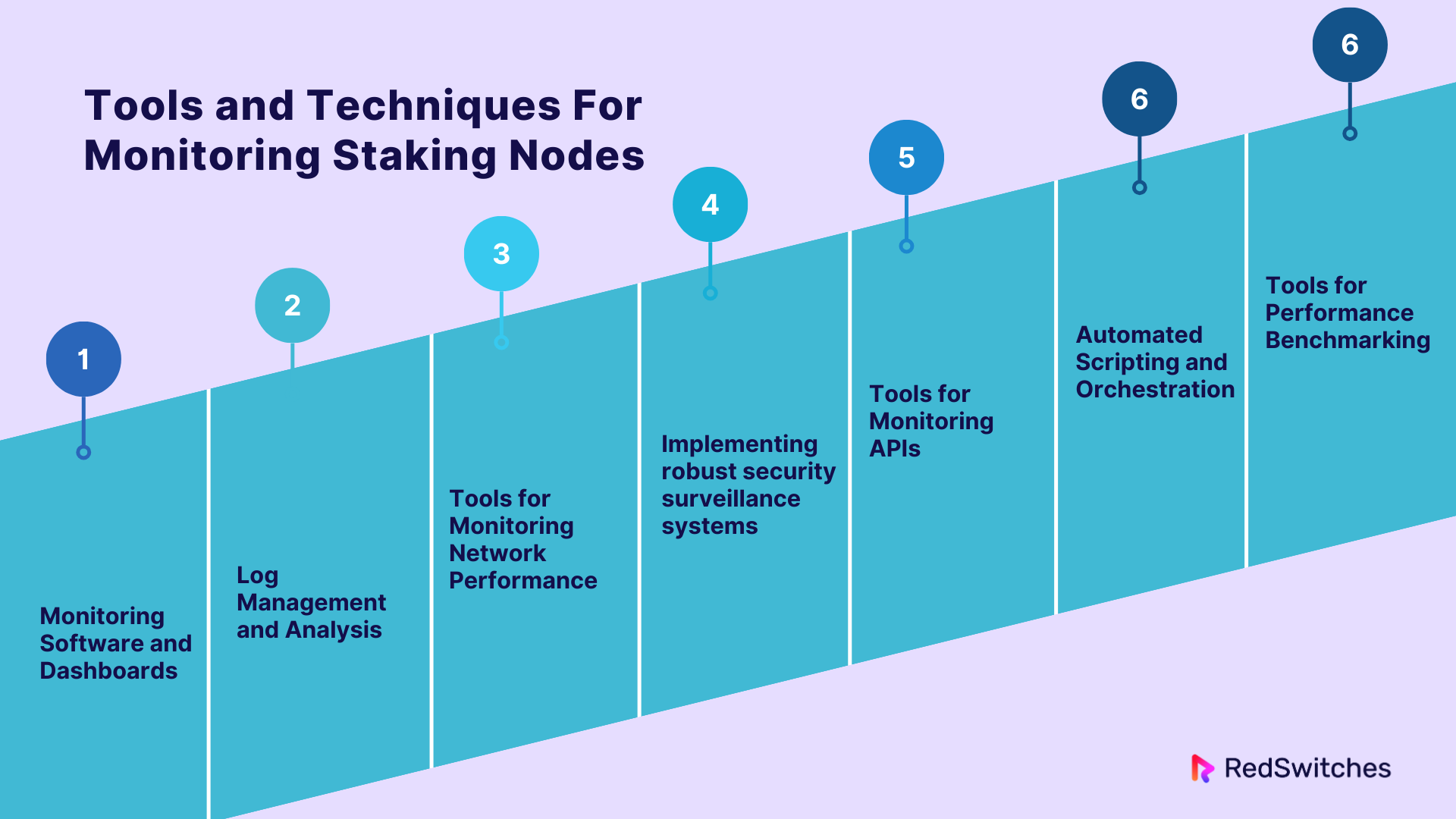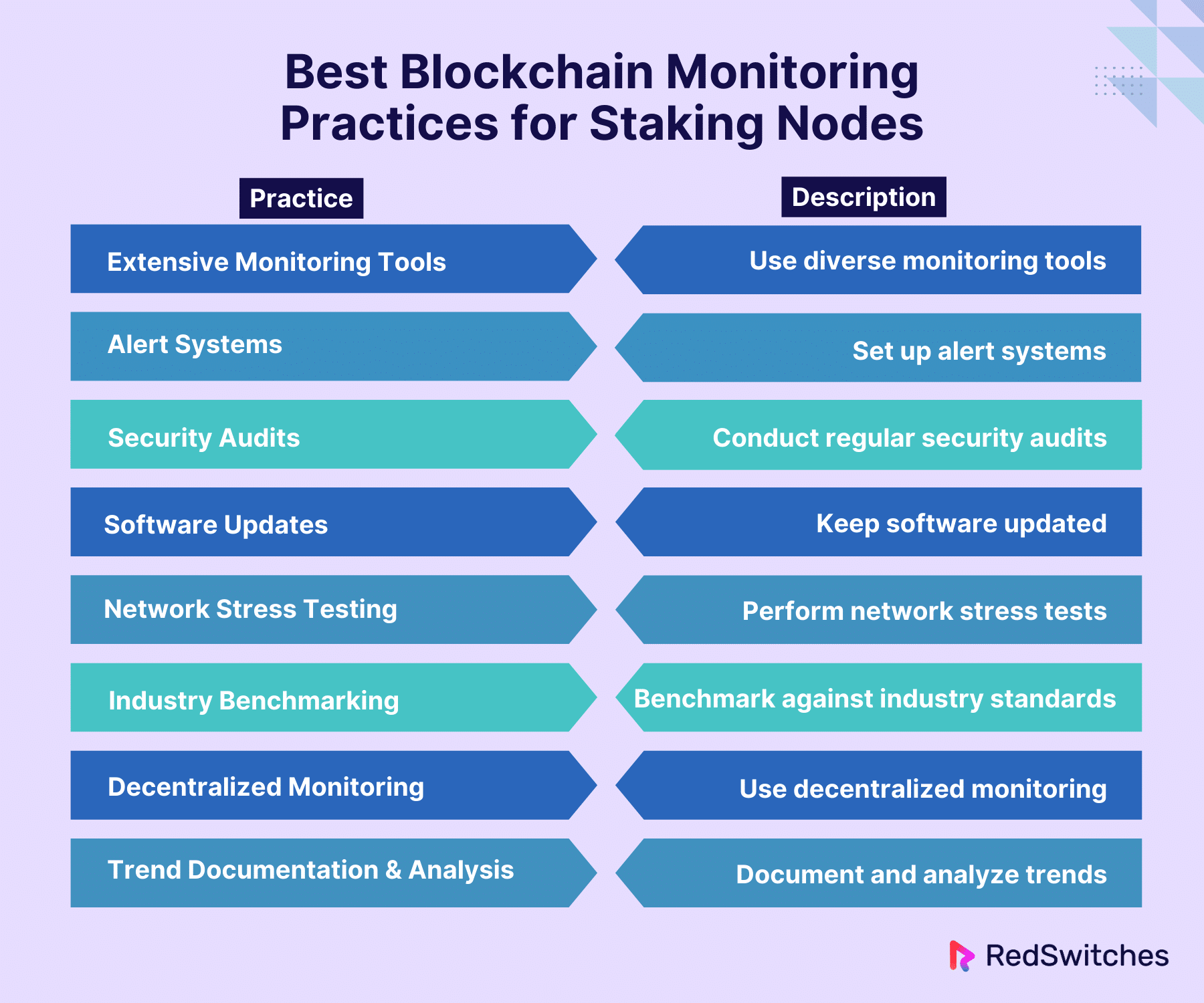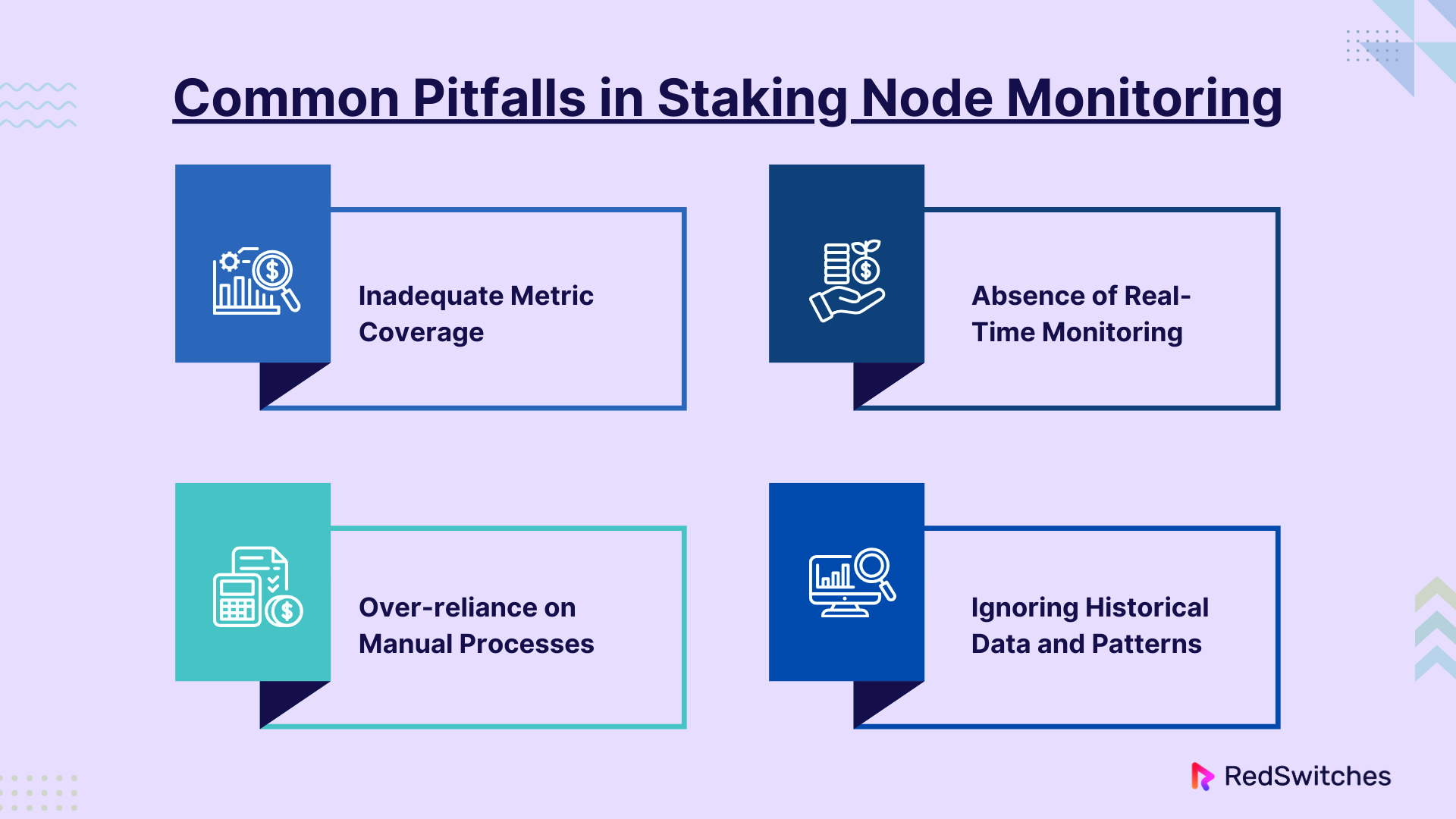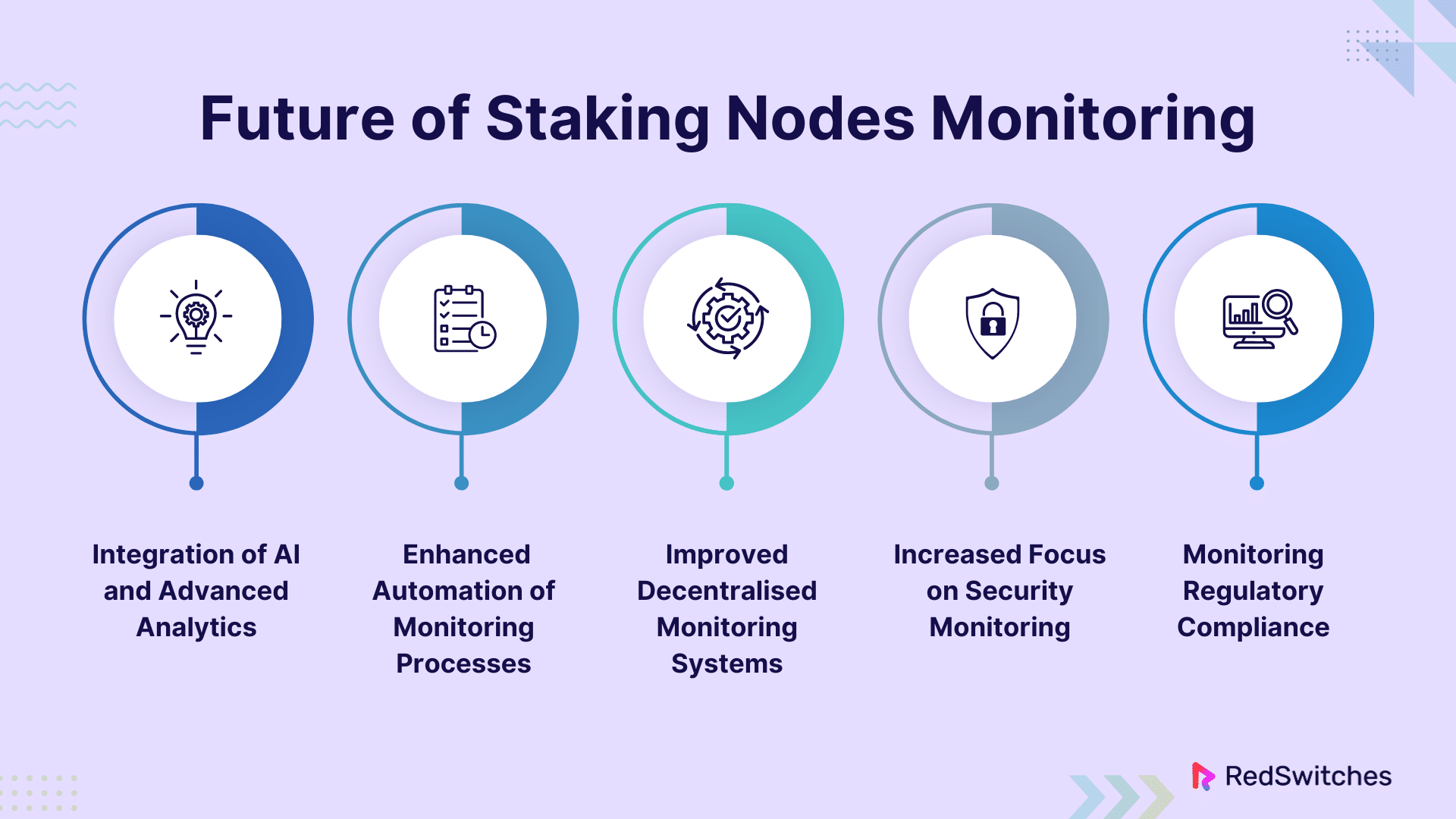Key Takeaways
- Employ a range of tools to monitor various aspects like performance, security, and resource utilization.
- Regular security audits and updates are essential to safeguard staking nodes.
- Implement real-time monitoring to detect and respond to issues quickly.
- Automate processes to reduce manual errors and streamline operations.
- Utilize decentralized monitoring tools to avoid single points of failure and increase network resilience.
- Ensure monitoring systems comply with evolving regulatory standards.
- Regularly review monitoring data to identify trends and optimize node performance.
As the use of cryptocurrency continues to soar, so do the challenges associated with ensuring a safe and secure financial environment. Staking nodes are now crucial to preserving network integrity. They also safeguard blockchains in the fast-growing field of blockchain technology. These nodes are the heart of proof-of-stake (PoS) networks. Their operation directly affects the security and effectiveness of the whole blockchain. Nonetheless, there are difficulties in controlling these essential elements. Monitoring is necessary. It ensures that staking nodes run well and are protected from threats.
This blog explores the best blockchain monitoring practices these essential blockchain components. It provides information on the tools and methods that can improve the security and efficiency of staking nodes. It covers the instruments, approaches, and measurements.
Comprehending these monitoring procedures is essential for anyone interested in technology, be it a blockchain developer, PoS network stakeholder, or tech fan, to appreciate the broader ramifications of blockchain sustainability and health fully.
Table Of Contents
- Key Takeaways
- What is Cryptocurrency Transaction Monitoring?
- What are Staking Nodes?
- Role of Staking Nodes in Blockchain Networks
- Key Metrics to Monitor in Staking Nodes
- Tools and Techniques For Monitoring Staking Nodes
- Best Blockchain Monitoring Practices for Staking Nodes
- Common Pitfalls in Staking Node Monitoring
- Future of Staking Nodes Monitoring
- Conclusion
- FAQs
What is Cryptocurrency Transaction Monitoring?
Credits: Freepik
Maintaining the integrity and security of the financial system is essential as cryptocurrencies gain popularity. Crypto transaction monitoring can help with it. It’s a technology designed to identify and examine suspicious behavior concealed in cryptocurrency transactions.
It is more like a vigilant observer monitoring the movement of virtual currency. It includes searching for any irregularities that could point to possible money laundering, sponsorship of terrorism, or other illicit activity.
Why Is It Important?
Cryptocurrency transactions can be attractive to bad actors due to their anonymity and speed. Transaction monitoring helps deter and detect suspicious activity by:
Identifying Red Flags: Monitoring tools can recognize patterns and behaviors . This includes patterns that deviate from regular user activity, potentially indicating illegal transactions.
Enhancing Compliance: Businesses operating in the crypto space are often subject to regulations. This requires them to implement transaction monitoring procedures.
Mitigating Risk: Businesses can reduce the possibility of being linked to illicit activities. Plus, they can safeguard their brand by promptly recognizing any questionable conduct.
Promoting Trust: Robust transaction monitoring measures can build trust among legitimate users. It can contribute to the overall health and stability of the cryptocurrency ecosystem.
Also Read Advanced Security Strategies for Crypto Staking
What are Staking Nodes?
Credits: Freepik
Blockchain networks’ infrastructure relies heavily on staking nodes. This is especially true for those who use a Proof of Stake (PoS) process. PoS systems reach consensus through users who “stake” their cryptocurrency as a security deposit. This is different from traditional Proof of Work (PoW) systems. They need vast amounts of processing power to validate transactions and protect the network. These members run staking nodes. The nodes verify transactions, build new blocks, and keep the blockchain secure and sound.
In essence, staking nodes are network members. They have restricted access to a portion of the native coin. They use it to take part in validating blocks. Nodes that suggest or approve fraudulent transactions risk losing part of their investment. They lose it as a punishment. This serves as both a financial incentive and a security mechanism.
The duties and rewards for network maintenance and governance increase with stake size. In addition to aiding in the decentralization process, this staking procedure drastically lowers the energy usage characteristic of PoW systems.
Also, a staking node needs to function well. It often needs special hardware and tech know-how. It also needs the financial commitment of staking coins. To join the consensus process, they must increase their chances of being selected to validate a block. This pays them transaction fees or freshly created coins. They must be online and working almost all the time. As a result, the resilience and effectiveness of the blockchain depend heavily on the health and performance of staking nodes, highlighting the need for best practices in blockchain monitoring.
Role of Staking Nodes in Blockchain Networks
Sto cking nodes are essential components in blockchain networks that use the Proof of Stake (PoS) consensus process. These nodes carry out several vital tasks that support the network’s operational effectiveness, security, and stability. Here is a thorough analysis of their responsibilities:
Transaction Validation
Verifying transactions is one of the primary duties of staking nodes. Staking nodes in Proof of Stake (PoS) systems are chosen according to their stake in the network, as opposed to Proof of Work (PoW) systems, where miners employ computing capacity to validate transactions and solve cryptographic puzzles. These nodes authenticate transactions, ensuring they follow the network guidelines and confirming the digital signatures to stop fraud like double-spending.
Block Creation
Staking nodes are crucial to a blockchain’s operation. They participate in creating new blocks. In proof-of-work (PoS), a node’s stake amount frequently influences its likelihood of being selected to start a new block. Nodes are rewarded for acting honorably when the stakes are more significant since selection chances increase with stake size. A node that has been chosen will group transactions into a new block and validate it before the block is added to the blockchain.
Network Security
Credits: Freepik
A key component of staking nodes’ operation in a blockchain is security. The bitcoin that has been staked works as collateral and may be lost if the node engages in hostile behavior or attempts to compromise the network. This system makes sure that nodes are financially motivated to keep the network’s integrity. A node risks losing its stake if it attempts to process fraudulent transactions or cause forks in the blockchain, acting as a strong disincentive against such behavior.
Governance
Staking nodes are involved in many blockchain networks’ governance choices. These nodes can cast votes on important matters like protocol updates or modifications to the governance guidelines. As voting power is usually correlated with stake size, a node’s influence over decisions that potentially impact the network’s functioning and future development increases with its level of investment in the network.
Distribution of Rewards
Running a staking node might bring in a lot of money. Transaction fees and occasionally new tokens from the network’s minting process are awarded to nodes chosen to validate transactions and produce new blocks. Because they incentivize node operators to make investments in and continue to sustain the network’s infrastructure, these incentives are essential to preserving a robust network ecology.
Strengthening Network Decentralization
Staking nodes can make blockchain networks more decentralized. In contrast to PoW, which necessitates a large amount of processing power and energy, PoS lowers the entry barriers to becoming a node, increasing the number of players involved in the network’s consensus process. This increased participation strengthens the network’s resistance to manipulation and attacks by preventing control from being too centralized.
Key Metrics to Monitor in Staking Nodes
Effective stake node monitoring necessitates a thorough strategy that includes multiple crucial parameters. These metrics inform stakeholders about the nodes’ health, security, and performance. They let them respond quickly to problems and make intelligent decisions. The following is a thorough analysis of the key performance indicators for staking nodes:
Node Availability and Uptime
Staking nodes depend on being active to participate in consensus and receive rewards; hence, node uptime is essential. Uptime monitoring contributes to ensuring that nodes are operating without interference. A node’s dependability and reputation in the network depend on its availability. Frequent outages might make it miss block formation and transaction opportunities. Consistent uptime requires preventing outages. You must also promptly bounce back from disruptions. This reduces the toll on node performance and stakeholder confidence.
Block Propagation Time
One crucial performance parameter is the speed at which a node can spread blocks throughout the network. Faster block propagation lowers the chance of network congestion and forks. It does this by ensuring that transactions are handled well. Delays in block propagation may show that a node performs poorly or the network has problems. These issues could limit the node’s capacity to help the blockchain. Efficient block propagation is crucial. It keeps the network in sync and transactions timely. It also speeds up and makes blockchain more reliable.
Stake Amount and Changes
Credits: Freepik
Tracking a node’s stake amount reveals its voting strength and prospective benefits. The chance a node will be chosen to make a block and its influence in the network can be significantly changed by stake amount changes. Variations in stake levels may also indicate changes in investor sentiment or tactical moves by significant players. You must understand these dynamics. They are crucial to predicting the node’s future performance and its place in the network. This enables stakeholders to make well-informed decisions regarding modifications to their staking plans.
Resource Usage
Metrics for CPU, RAM, and disc use are essential. They help us judge the health of staking nodes. Excessive resource consumption may indicate overwork or technical problems on a node, which could cause failures or performance deterioration. Monitoring these data aids in maximizing node performance and identifying issues before they can compromise stability. By keeping the node responsive and effective, effective resource management helps to prevent problems that can result in fines or lower incentives for subpar performance.
Network Latency and Connectivity
For nodes to interact with the rest of the blockchain network efficiently, there must be minimal latency and good network connectivity. Network performance monitoring can assist in locating geographical latency or connectivity problems that may prevent a node from synchronizing with the blockchain or taking part in consensus. A node must be able to maintain real-time contact with the network to validate transactions and create blocks promptly. This is known as optimal connectivity. This is especially crucial in distributed networks since latency can cause a node to lose synchronization with other nodes, which could negatively affect the dependability and efficiency of the node.
Tools and Techniques For Monitoring Staking Nodes
Effective staking node monitoring needs advanced tools and brutal methods. They make sure of thorough supervision and administration. The following are some crucial instruments and methods utilized in this regard:
Monitoring Software and Dashboards
To monitor staking node health and performance, you need specialized monitoring software and dashboards. These tools show vital parameters. These include uptime, resource use, and block propagation times. They show them with real-time data visualizations and analytics. Prometheus and Grafana are well-known software programs. They provide configurable dashboards. The dashboards can be adapted to the unique needs of blockchain operators. This allows them to make data-driven choices and immediately spot patterns and abnormalities. These tools also make it easier to set up alarm systems that can inform operators of serious problems that require quick care.
Log Management and Analysis
Staking node problems can only be identified and fixed with efficient log management and analysis. Staking nodes create logs. You can collect, process, and visualize them with tools like Splunk or ELK Stack. ELK Stack is Elasticsearch, Logstash, and Kibana. They can offer insights into security and operations. Node operators can track historical data. They use it to comprehend past incidents and improve node performance. They do this by examining these logs. Also, they ensure all node operations are documented and available for audits. They help ensure compliance with rules.
Tools for Monitoring Network Performance
Staking nodes need to keep excellent network performance. This means having low latency and staying well connected to the blockchain network. Tools such as Nagios or Zabbix monitor latency, bandwidth consumption, and network health. They provide thorough reports and warnings for any abnormalities in the network. These technologies prevent network problems. This is important in a blockchain context. Consensus and transactions need quick reactions.
Implementing Robust Security Surveillance Systems
Credits: Freepik
It is necessary, given the financial and security requirements of staking nodes.
SIEM systems, like IBM QRadar or Splunk, provide security monitoring. They cover real-time surveillance, threat detection, and incident response. They gather and check network data. They do this to find suspicious activity or security breaches. SIEM technologies protect staking nodes from many cyber attacks. They do this by using advanced analytics and threat intelligence. This protection guarantees the integrity and reliability of blockchain transactions.
Tools for Monitoring APIs
APIs are essential for communication between staking nodes and other blockchain infrastructure components. Monitoring APIs with tools like Postman and Runscope is vital. They ensure that APIs are working well. The tools assess API endpoints. They check for availability, performance, and accurate responses. This ensures smooth communication across blockchain networks. Staking services’ timeliness and dependability improve through ongoing API monitoring. It helps identify and diagnose problems before they affect the node.
Automated Scripting and Orchestration
To keep staking nodes running well, you need automated scripting and orchestration tools. These include Ansible, Puppet, or Kubernetes. The tools automate node infrastructure setup and management. They lower the risk of human mistakes and ensure consistent environments across many nodes. Automation saves time. It also promotes the best node setup and maintenance practices. This allows for smooth and scalable operations as network demands increase.
Tools for Performance Benchmarking
Staking nodes’ effectiveness must be regularly evaluated against predetermined benchmarks or metrics. Performance benchmarking tools are crucial for this process. Blockchain networks can assess a blockchain’s performance using various benchmarks. These include transaction throughput, latency, and resource usage. They use tools such as Hyperledger Calliper. Benchmarking facilitates understanding node performance under various network conditions and can direct optimization efforts to improve system performance.
Best Blockchain Monitoring Practices for Staking Nodes
We must monitor staking nodes well. This is key to their performance and security in a blockchain network. These eight best practices are for monitoring blockchains. They are made for staking nodes.
Employ Extensive Monitoring Tools
Use many tools to monitor node function. This includes resource usage, network stats, performance, and security. Tools like Prometheus greatly aid real-time performance monitoring. The ELK Stack significantly improves log management. It provides deep insights into system events and logs. Also, for thorough surveillance, SIEM systems like IBM QRadar or Splunk are essential. They help find and fix security risks. These technologies combined to let us understand node health fully. It allows for proactive management and quick reactions to operation problems.
Establish Alert Systems
Provide robust alerting systems. They inform relevant parties of significant problems. These problems affect the security or operation of staking nodes. Set up notifications for many situations. These include unapproved access attempts, high resource use, network latency spikes, and outages. Customizing notifications to meet individual needs helps. It allows for prompt issue resolution. This cuts downtime and stops potential breaches. Keeping things running and alerting stakeholders requires effective alert systems. They must notify them right away of significant situations.
Also read Server Downtime: Causes, Effects, and How to Prevent It
Regular Security Audits
Conduct thorough security audits and reviews often. Do this to find and fix vulnerabilities in the node’s infrastructure and software. The audits use advanced scanning tech. They can find security flaws before they are exploited. Then, they allow for quick fixes. We need frequent audits. They make sure we follow industry security standards. They also keep our security strong and up-to-date against the always-changing cyber threats. In addition to fostering a culture of security within the company, this technique increases dependability and trust among stakeholders and network users.
Maintain Node Software Updates
To get the latest security fixes and performance improvements, update node software and its dependencies often. Updating software is essential. It stops known vulnerabilities from being exploited and adds improvements. They make node performance and user experience better. Creating an automated update procedure may reduce security flaws. They come from out-of-date software or wrong configurations. It ensures consistency across all nodes. Additionally, by simplifying maintenance, this automation reduces human error. It also lessens the IT workload.
Conduct Network Stress testing
Do thorough stress tests often. They will show how well staking nodes handle harsh conditions. These tests are crucial. They find possible bottlenecks and resilience problems. These issues can endanger the network’s integrity under pressure. Operators can find needed infrastructure changes. They can do this by modeling scenarios like high traffic volumes and rapid transaction speeds. Doing this will also help them understand the nodes’ operational limits. By being proactive, the network is sure to stay resilient and adaptable. It can handle sudden traffic spikes without any decrease in performance.
Benchmark Against Industry Standards
Use tools like Hyperledger Calliper. Use them to continuously test and assess your nodes’ performance. Compare it to industry standards and best practices. You need this benchmarking. It lets you find performance gaps and see how your nodes compare to your competitors. You can use the knowledge from these comparisons to make strategic choices about node upgrades. This will lead to advancements that keep your business competitive in a rapidly changing blockchain ecosystem. Additionally, this practice promotes excellence in the sector by encouraging adherence to high standards.
Employ Decentralised Monitoring Techniques
Implement decentralized monitoring techniques that provide objective, external views on stake node performance. These resources, which include independent monitoring services and blockchain explorers, offer vital information about node responsiveness and availability from various geographical areas and network conditions. By adding a degree of openness and objectivity, this decentralized monitoring technique improves the accuracy of the data gathered and offers a more nuanced view of network performance in various settings.
Document and Analyze Trends
Keep thorough and well-organized records of all monitoring data and perform routine analyses to spot patterns or reoccurring problems. This thorough documentation is indispensable for efficient troubleshooting, strategic planning, and projecting future requirements for node capacity and scalability. Frequent trend analysis is necessary to identify inefficiencies or slow performance reductions. This allows for timely adjustments that can avert more serious problems later on. Keeping thorough records also facilitates processes for ongoing improvement and helps ensure regulatory compliance.
Common Pitfalls in Staking Node Monitoring
Monitoring staking nodes is essential for keeping blockchain networks safe. This is especially true for Proof of Stake (PoS) mechanisms. Effective monitoring procedures, however, can be hampered by a few typical mistakes, which could result in problems with performance, security flaws, and inefficiencies in operations. Here’s a thorough examination of a few of these typical pitfalls:
Inadequate Metric Coverage
One of the biggest mistakes made when monitoring staking nodes is failing to capture a wide variety of indicators. You must regularly check critical metrics. These include resource use, node uptime, block time, and security. If these metrics are not thoroughly covered, the monitoring system may have blind spots. This makes it more challenging to identify and resolve problems before they become serious. This carelessness can cause unexpected outages, decreased node performance, and neglected security risks..
Absence of Real-Time Monitoring
Not using real-time monitoring can worsen problems. It delays the finding of important issues and slows reaction times. You need real-time data to make fast decisions. Staking nodes operate in a place where conditions can change quickly. Late data leads to old answers. Old answers are ineffective. They miss chances to validate transactions or expose systems to risks.
Over-Reliance on Manual Processes
Another typical mistake is relying too much on manual processes to manage and monitor staking nodes. In addition to being labor-intensive, manual monitoring is also prone to human error. It may result in inconsistent data processing and sluggish alert response times. By automating the management and monitoring, resources can be directed to more critical tasks. It also ensures timely and consistent actions and reduces human error.
Ignoring Historical Data and Patterns
If we don’t analyze historical data and spot patterns, stakeholders may not understand their nodes’ long-term performance and problems. Analyzing historical data is essential for capacity planning, behavior prediction, and node performance enhancement. Operators who don’t use historical data risk missing patterns that point to underlying issues or optimization opportunities.
Future of Staking Nodes Monitoring
Technology is advancing. Networks are growing more complex. It seems that monitoring staking nodes in blockchain networks will undergo big changes. These trends will likely influence how staking nodes are watched.
Integration of AI and Advanced Analytics
Monitoring will increasingly employ artificial intelligence (AI) and advanced analytics. These technologies can analyze data quickly and accurately. They can find problems before they become serious. AI-driven anomaly detection spots odd patterns. These diverge from the typical behavior. They enable preventive maintenance and security actions. Machine learning models can also be taught to optimize security and performance. They do this automatically based on past data and current network conditions.
Enhanced Automation of Monitoring Processes
Blockchain settings are getting more complex. Monitoring process automation will become more critical. It’s needed to manage the size and pace of operations. In addition to tracking security and performance indicators, automated monitoring systems will instantly modify resources and configurations to satisfy network demands. This will cut human error. It will also reduce the need for manual intervention. This will lead to more constant uptime and better resource management.
Improved Decentralised Monitoring Systems
Credits: Freepik
In the future, monitoring systems will be more decentralized. They will reflect the key features of blockchain. Systems are less prone to single points of failure. They are also more resilient and fault-tolerant. You can achieve this through decentralized monitoring networks. They gather information from many sources. This lets them give a fuller picture of the network. They ensure more reliable and precise monitoring.
Increased Focus on Security Monitoring
The security of staking nodes will become more critical. This is as they become more strategic and financially significant. Monitoring solutions will have more advanced cybersecurity tools and protocols. They will use them more often to find threats and take quick action. This includes adding threat intelligence platforms and better intrusion detection systems. It also involves making security frameworks for blockchains. These are tailored for the unique challenges of decentralized ecosystems.
Monitoring Regulatory Compliance
Blockchain tech is advancing. It is being added to traditional financial institutions. Keeping regulatory compliance will be crucial to node functionality. Monitoring systems must be equipped with features that guarantee adherence to international regulatory frameworks. This includes those controlling cross-border data flows, financial transactions, and data protection. To do this, all node activity must be tracked and recorded audibly and transparently.
Conclusion
Ensuring blockchain networks’ integrity, performance, and security requires efficient monitoring of staking nodes. Stakeholders may ensure their nodes operate well and safely. They can do this by using strong alarms, doing frequent security audits, and installing the latest software patches. These skills will be improved by adding AI, advanced analytics, and more automation. This will happen as technology advances.
Working with a reputable service provider like RedSwitches can help you take advantage of these best practices for blockchain monitoring. We make sure your blockchain operations are future-proof and efficient. We do this by providing the infrastructure and knowledge needed to support the complex monitoring systems for staking nodes.
Get ready to have the confidence to handle blockchain with our expert advice. This shall let you focus on boosting your staking profits and network contributions.
FAQs
Q. Best Blockchain Monitoring Practices: How is blockchain monitored?
Blockchain is tracked using tools that measure performance metrics, logs, and security to ensure that nodes run effectively and safely.
Q. How does blockchain enable traceability?
Blockchain facilitates traceability by logging transactions in an unchangeable, visible ledger, which makes it simple to follow the ownership and history of assets.
Q. Can we track transactions in blockchain?
Blockchain transactions may be tracked using their distinct transaction IDs and the historical data available on the public ledger.
Q. What are the essential best practices for crypto transaction monitoring in 2024?
The best practices for monitoring crypto transactions in 2024 include using tools for blockchain analytics. They also include doing risk assessments. They add AML measures and track rule changes.
Q. How can blockchain analytics help in monitoring cryptocurrency transactions?
Blockchain analytics tools can show transaction patterns and risks in blockchain networks. They enable effective monitoring and analysis of crypto transactions by revealing money laundering activities.
Q. What is the significance of AML in crypto transaction monitoring?
AML, or Anti-Money Laundering, is vital in crypto transaction monitoring. It helps to reduce money laundering risks. It also helps to follow regulations and make crypto transactions more transparent.
Q. How can cryptocurrency businesses benefit from using blockchain analytics tools?
Cryptocurrency businesses can use blockchain analytics tools. They can use them to cut risks, improve compliance, and find suspicious activities. The tools also help optimize transaction monitoring and analysis.
Q. What are the 9 best practices for effective crypto transaction monitoring in 2024?
The 9 best practices for monitoring crypto transactions in 2024 include using visualization tools, using advanced blockchain analytics, doing thorough risk assessments, following compliance measures, and using case management solutions.
Q. How do blockchain nodes contribute to effective transaction monitoring?
Blockchain nodes play a crucial role in controlling the blockchain network. They give live data on transactions, addresses, and activities in the blockchain. This helps better monitoring and analysis.
Q. What are some recommended blockchain analysis tools for monitoring and analyzing crypto transactions?
Some tools are recommended for analyzing blockchain. They help track crypto transactions. They include Crystal Blockchain, blockchain forensics solutions, compliance tools, and visualization platforms. These tools help track deposits, withdrawals, and transaction flows.
